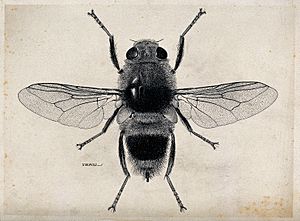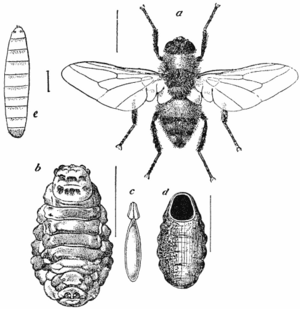Warble fly facts for kids
Quick facts for kids Warble flies |
|
|---|---|
 |
|
| Ox warble fly (Hypoderma bovis) | |
 |
|
| Life cycle | |
| Scientific classification |
|
| Kingdom: | Animalia |
| Phylum: | Arthropoda |
| Class: | Insecta |
| Order: | Diptera |
| Family: | Oestridae |
| Subfamily: | Hypodermatinae |
| Genus: | Hypoderma Latreille, 1818 |
| Species | |
|
|
A warble fly is a type of large fly that belongs to the genus Hypoderma. These flies are known as ectoparasites, which means they live on the outside of another animal and get their food from it. Warble flies mostly affect large animals like horses, sheep, goats, and sometimes even humans.
Female warble flies lay their eggs on the front legs of these animals. Once the eggs hatch, the tiny larvae (young flies) burrow into the animal's skin. This can cause discomfort and even harm to the animal. While warble flies have been mostly removed from many European countries, new infestations can still happen.
Contents
The Life Cycle of a Warble Fly
Warble flies go through several stages in their life, just like many other insects. Understanding their life cycle helps us see how they affect animals.
Egg Laying and Hatching
Adult female warble flies are active during warm months. They fly around and lay their tiny eggs on the hair of animals, usually on their legs or lower body. Each fly can lay hundreds of eggs. After a few days, the eggs hatch into small larvae.
Larval Development Inside the Host
Once hatched, these larvae don't stay on the surface. They burrow into the animal's skin. From there, they travel through the animal's body, often moving towards the back. They create small bumps, called "warbles," under the skin. Inside these warbles, the larvae continue to grow and develop. They make a small breathing hole in the animal's skin to get air. This stage can last for several months.
Pupation and Adult Emergence
When the larvae are fully grown, they leave the animal's body through the breathing hole. They then drop to the ground and burrow into the soil. Here, they change into a pupa, which is a resting stage. After a few weeks, the adult warble fly emerges from the pupa. Adult warble flies do not feed; their main goal is to mate and lay eggs, starting the cycle all over again.
How Warble Flies Affect Animals
Warble flies can cause several problems for the animals they infest.
Discomfort and Stress
When adult warble flies are flying around trying to lay eggs, animals can become very stressed. They might run around wildly or try to kick the flies away. This behavior, called "gadding," can lead to injuries.
Skin Damage and Infection
The larvae burrowing and growing under the skin can cause pain and irritation. The holes they make in the skin can also become infected by bacteria. This can lead to skin problems and make the animal uncomfortable.
Economic Impact
For farmers, warble flies can cause financial losses. The damage to the animal's hide (skin) makes it less valuable. Also, the stress and discomfort can cause animals to eat less or grow slower, affecting their health and productivity.
Keeping Animals Safe
Over the years, people have found ways to control warble flies and protect animals.
Prevention and Treatment
In many places, farmers use special medicines to treat animals and kill the larvae before they cause serious harm. These treatments are often given in the fall or winter. Good hygiene and regular checks of animals can also help spot infestations early.
Eradication Programs
Some countries have successfully run programs to completely get rid of warble flies. These programs involve widespread treatment of animals and strict rules to prevent new flies from entering the area. This has greatly reduced the number of warble flies in many parts of the world.
Images for kids
See also
 In Spanish: Barros para niños
In Spanish: Barros para niños


